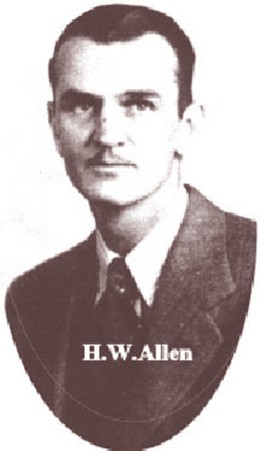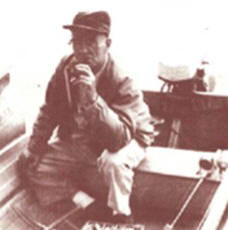|
Class of 2010
Innovator / Inventor / Contributor
to the Sport
 It
is hard to imagine that any other single invention has so
impacted a sport like the compound bow has influenced archery.
But Holless Wilbur Allen's new bow design did just that - it
revolutionized archery and bowhunting. The invention didn't
come easy. It
is hard to imagine that any other single invention has so
impacted a sport like the compound bow has influenced archery.
But Holless Wilbur Allen's new bow design did just that - it
revolutionized archery and bowhunting. The invention didn't
come easy.
Allen, like many bowhunters, was frustrated that whitetail deer
could jump out of the way of his slow-moving hunting arrows. He set about trying to
increase arrow speed by building bows that incorporated his
ideas. He built a long-handled bow with very short, extremely
recurved limbs. Nope. He tried shooting a short,
light-weight arrow down a track attached to his bow and got a
little increased speed but poor penetration; this bow broke in
testing! After reading up on kinetic energy in his youngest
son's high school physics book, he mounted a small standard
aircraft pulley into the notched ends of a homemade bow with its
recurves cut off. With a very long bowstring he'd made, he
formed a "block-and-tackle-like" arrangement on this bow, with
the rear string span as the bowstring. Again, no improvement.
Other ideas were tried, but nothing gave him the speed he was
looking for.
of his slow-moving hunting arrows. He set about trying to
increase arrow speed by building bows that incorporated his
ideas. He built a long-handled bow with very short, extremely
recurved limbs. Nope. He tried shooting a short,
light-weight arrow down a track attached to his bow and got a
little increased speed but poor penetration; this bow broke in
testing! After reading up on kinetic energy in his youngest
son's high school physics book, he mounted a small standard
aircraft pulley into the notched ends of a homemade bow with its
recurves cut off. With a very long bowstring he'd made, he
formed a "block-and-tackle-like" arrangement on this bow, with
the rear string span as the bowstring. Again, no improvement.
Other ideas were tried, but nothing gave him the speed he was
looking for.
Wilbur Allen loved devices and was driven to understand how they
worked. At one Christmas dinner, he completely disassembled
his oldest sister's new 35mm German-made reflex camera, parts
laying all over the dining table. His wife was frantic with
what she saw happening, but after grasping how it worked, he
reassembled it in perfect working order. His sister never knew.
The mechanical knowledge gained from years of such curiosity was
used to build what he could not afford. Income came from a
business at home making basket frames of steel wire for the
nation's florist industry. All equipment for this was built by
him, including a machine that straightened steel wire from a
200-lb. coil and cut it to selected length, automatically. It
was built from the parts of two washing machines bought at a
junk yard and assorted stuff at home. The commercial equivalent
at the time cost $50,000; his out-of-pocket cost was $20.
He also loved hunting and fishing. When he learned about
paddlefish, he could not afford the necessary deep-sea rod and
reel, so he built them, too. Using scrap steel wire and sheet
metal, the reel was an open-faced spinning design with the crank
aligned parallel with the rod and operating a V-belt drive.
Reel drag was adjustable by a built-in tensioning device for
the V-belt.
 Such
was the innovative spirit that drove H.W. Allen to spend hours
contemplating a bow that would shoot arrows faster. It really
comes as no surprise, then, that lightning would strike one
evening in 1966 while he was studying his pulley bow. "What
if," he thought, "I positioned the pulley's pivot hole
off-center?" That was it! Within two days, Wilbur Allen had
built the first compound bow. It was crude - the eccentrics
were of wood, the truss handle made of pine boards, limb cores
of oak flooring that he laminated with fiberglass roving, all
held together with epoxy, nails, a few bolts and a little
Elmer's glue. But it worked! He achieved a significant
increase in arrow speed over a recurve bow of equal draw weight,
relaxation of draw weight of 15%, and the ability to use
lighter arrows than the equivalent recurve. His bow design
produced impressive performance. Such
was the innovative spirit that drove H.W. Allen to spend hours
contemplating a bow that would shoot arrows faster. It really
comes as no surprise, then, that lightning would strike one
evening in 1966 while he was studying his pulley bow. "What
if," he thought, "I positioned the pulley's pivot hole
off-center?" That was it! Within two days, Wilbur Allen had
built the first compound bow. It was crude - the eccentrics
were of wood, the truss handle made of pine boards, limb cores
of oak flooring that he laminated with fiberglass roving, all
held together with epoxy, nails, a few bolts and a little
Elmer's glue. But it worked! He achieved a significant
increase in arrow speed over a recurve bow of equal draw weight,
relaxation of draw weight of 15%, and the ability to use
lighter arrows than the equivalent recurve. His bow design
produced impressive performance.
Allen filed for a patent on his new bow on June 23, 1966. It
was granted in 1969. By 1977, there were 100 different models
of compound bows available, only 50 recurve models. After only
ten years of production, two thirds of the available choices
were compounds.
Holless Wilbur Allen had laboriously contrived a rather
complicated device that performed a relatively simple task -
shoot an arrow fast. He fought hard to get approval from state
game agencies for its use in bowhunting and succeeded.
Likewise, competitive archery organizations finally approved
the compound for tournament shooting.
The rest is history.

Doug Allen, explains his father's compound bow
prototype
to
AHOF Executive Director, Diane Miller during Museum
Opening. September 14, 2012
Notes of Interest
Ø
Recognized as “The Father of the Compound Bow”
Ø
Sought Ways During the Early 1960s to Achieve Faster Arrow Speed
for Deer Hunting
Ø
Experimented with Modified Recurve Bows Fitted with Pulleys To
Achieve a Block & Tackle Effect
Ø
Perfected His Invention in 1965 and Began Limited Production in
1967 after Bow Manufacturers Expressed No Interest in the New
Design
Ø
The Compound Bow Eventually Revolutionized Modern Archery
|